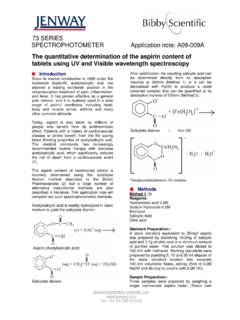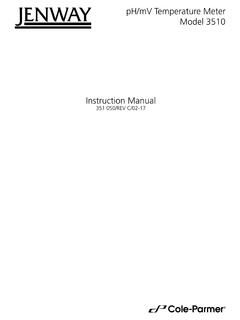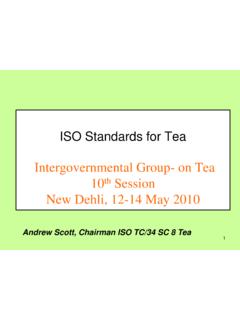Transcription of A09-010A Determination of Caffeine in Beverages …
1 Tel: +44 (0)1785 810433 73 SERIES SPECTROPHOTOMETER Application note: A09-010A The quantitative Determination of Caffeine in Beverages and soft drinks using UV wavelength spectroscopy Introduction Caffeine is a naturally occurring alkaloid which is found in the leaves, seeds or fruits of over 63 plants species worldwide. The most common sources of Caffeine are coffee, cocoa beans, cola nuts and tea leaves and the worldwide consumption of products derived from these natural materials means that Caffeine is one of the most popular and commonly consumed drugs in the world. Caffeine s popularity stems mainly from the fact that it is a pharmacologically active substance and a mild central nervous system stimulant.
2 Caffeine (1, 3, 5-trimethylxanthine) It is generally agreed that there is little risk of harm when a person consumes less than 300 mg of Caffeine a day1,2. However at times of anxiety or stress, or during pregnancy, the FSA recommends consumption of less than 200 mg a day3. While there are no regulatory requirements to control or label food products with their Caffeine content, numerous studies have been carried out to determine the typical Caffeine content of commonly consumed Beverages . A wide variety of methods have been employed with High Pressure Liquid Chromatography (HPLC) being the method of choice in many analytical studies as it commonly is subject to fewer interferences than alternative methods.
3 HPLC is an expensive and resource-hungry technique that is not typically found in the scientific teaching labs of schools and colleges. Therefore this application note will investigate an alternative analytical method that uses UV spectroscopy to analyse and quantify the Caffeine content of some common Beverages and soda drinks. Caffeine can be extracted from aqueous solutions with chlorinated solvents such as dichlormethane and chloroform, a technique commonly employed commercially to de-caffeinate coffee and tea. After the Caffeine is extracted it can be analysed directly by measuring the absorbance of the solvent solution at 260nm. Five samples were chosen to include the commonly consumed Beverages and soft drinks including instant coffee (Nescafe), brewed tea (PG Pyramid Tea Bags), Coca Cola, Pepsi Cola and Red Bull.
4 The analysis is performed on a Jenway 7305 spectrophotometer controlled using the free-of- charge PC software, supplied with each model in the 73 series. The software allows the user to emulate all measurement tasks normally performed on the instrument with the additional benefit of allowing data to be seamlessly transferred to external Microsoft office applications. Methods Reagents Caffeine Dichloromethane Purified water Standard Preparation:- A 1000ppm stock standard of Caffeine was prepared by dissolving of Caffeine in purified water. Working standards were prepared by pipetting 25, , 10, , 5 and aliquots of the stock standard solution into separate volumetric flasks and diluting to volume with purified water. Sample Preparation:- 200ml aliquots of boiling purified water was added to each of two 250ml beakers containing 2g of instant coffee and a single PG pyramid tea bag ( of dried tea leaves) respectively.
5 The coffee and tea preparations were stirred for 30 seconds using a magnetic stirrer (500rpm) and allowed to cool to room temperature. The soft Tel: +44 (0)1785 810433 drink samples were used as supplied by the manufacturer. Caffeine Extraction Procedure:- A 50ml aliquot was taken from each working standard or sample solution. This aliquot was placed into a separating funnel and 25ml of dichloromethane was added. The Caffeine was extracted by inverting the funnel at least three times, venting the funnel after each inversion. The dichloromethane layer was removed to a clean flask and the extraction procedure was repeated twice more and the solvent layers combined. Sample Measurement:- Aliquots of the extracted standards were placed into quartz cuvettes (part code 035 028) and analysed using a 7305 spectrophotometer.
6 The Photometrics mode was accessed by selecting the Photometrics icon from the main menu screen in the PC software and measurements were performed according to the procedure described in the instrument and PC software operating manuals. Microsoft Excel was used to tabulate the measurement data and perform a linear regression analysis. This allowed a concentration factor to be calculated which was then input into the settings in the Concentration mode of the 7305 PC software. The concentration mode was then used to quantify the Caffeine concentration of the sample solutions with measurements performed against a dichloromethane blank. Results The absorbance values of the six working standard solutions were measured; the measured values are shown in Table 1.
7 Caffeine Std Conc. (ppm) Absorbance 100 50 40 30 20 10 Table 1. Standard absorbance values. A linear regression of absorbance vs standard concentration, forced through the origin, gave equation 1. (1) y = A linear regression of concentration vs absorbance allowed the factor of , included in equation 2, to be determined. Equation 2 was then used to calculate the concentration of Caffeine in the extracted sample solution, from the solution s measured absorbance value. (2) Conc (ppm) = x Abs The Caffeine content of the extracted sample solutions are shown in Table 2.
8 Sample Sample Abs Concentration of Extracted Sample (ppm) Nescafe PG Tea Coca Cola Pepsi Cola Red Bull Table 2. The Caffeine concentration of the extracted sample solutions. The final Caffeine content of the beverage under test is then calculated from the extracted sample solution s concentration using equation 3. Dividing this value by the volume of the drink gives the Caffeine content per ml. 2(ml)(mg) (ml)(Total Sample Vol ) (3) Caffeine content = Conc (ppm) x (Measured Sample Vol ) x 1000 SampleTotal Sample Vol (ml)Measured Sample Vol (ml) Caffeine Content Per Serving (mg) Caffeine Content (mg/ml)Nescafe200 50 PG Tea200 50 Coca Cola 330 50 Pepsi Cola 330 50 Red Bull 250 50 Table 3.
9 The calculated Caffeine content of Beverages and soft drinks. Of the five samples tested the sample of Red Bull had the highest total and per ml content of Caffeine . When ranking the drinks in terms of Tel: +44 (0)1785 810433 Caffeine content per serving the order was Red Bull Pepsi Cola Instant Coffee Coca Cola PG Tea. Instant coffee and PG Tea rise from third and fifth places to second and third respectively when the drinks are ranked in order of the Caffeine content per ml. Conclusions When the results obtained in this application note are compared to data published in previous reports, or by the drinks manufacturer, it can be seen that the results obtained using the 7305 spectrophotometer are broadly in line with expectations with the exception of the two cola drink samples.
10 Sample Published Caffeine Content Per Serving Nescafe (2g) 64mg4 Instant Tea (1 bag) 40mg5 Coca Cola (330ml) 35mg6 Pepsi Cola (330ml) 38mg6 Red Bull (250ml) 80mg7 Table 4. Published Caffeine Content of Beverages and Soft Drinks The higher than expected values obtained for the cola drink samples may be the result of additional compounds, that absorb light at the wavelength used in this application note, being extracted into the dichoromethane sample solution. The resulting solution would give a higher than expected absorbance reading and calculated Caffeine content. Alternative extraction procedures could be investigated to see of the interfering compounds could be excluded from the extraction solution. References 1. Smith AP.











